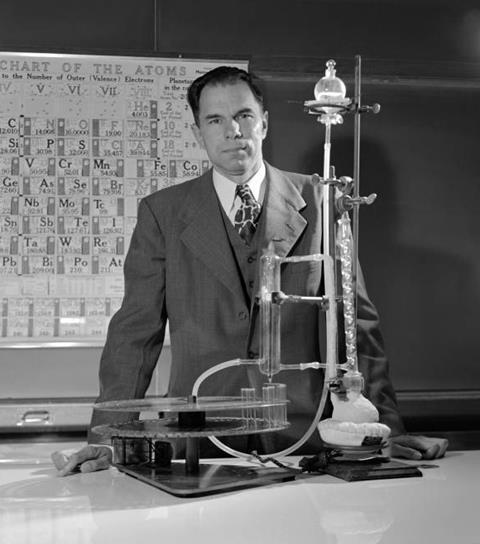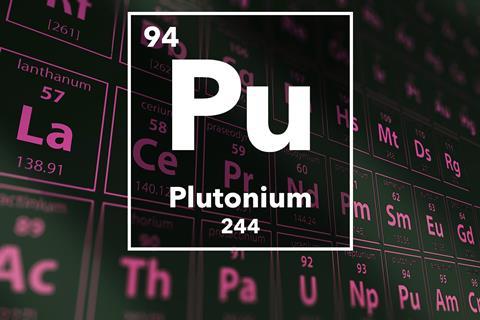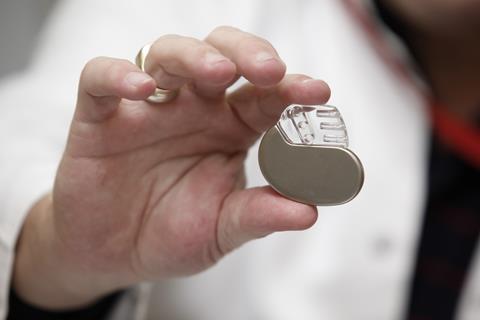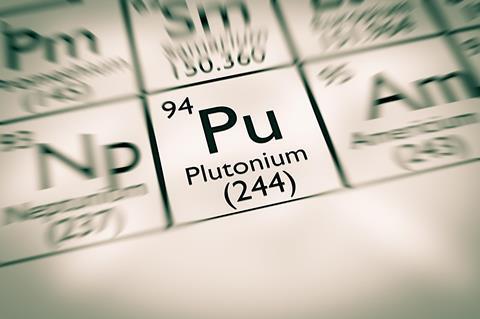Chris Smith
Hello, this week on Chemistry in its Element a substance that most people think is man made but in fact often turns up in the centres of stars. It also packs a huge nuclear punch when it's in the right sort of warhead and also has the power to be a super conductor. The only problem is its radio active and that means that when it decays it tends to fall apart. It is of course plutonium and here to spell it out is Cambridge University's Ian Farnan.
Ian Farnan
Plutonium's often billed as the 'most toxic substance known to man'. Just the word plutonium instils a dread in people's minds – and it's the early history of plutonium that established its dark side – and it's a reputation that's been hard to shake-off since.
Glenn Seaborg discovered plutonium at Berkeley in 1940, and in the following spring, when it was found that it could sustain a nuclear chain reaction, he secretly wrote to President Roosevelt, to inform him of that this substance had the potential to be a powerful source of nuclear energy. And from that moment the race was on to produce significant amounts to supply a secret project codenamed the Manhattan Engineering District, the goal of which was to produce a nuclear bomb.

Anyone familiar with the iconic image of the mushroom cloud understands the tremendous explosive power of a correctly controlled detonation of plutonium. The energy density is mind-boggling: a sphere of metal 10 cm in diameter and weighing just 8 Kg is enough to produce an explosion at least as big as the one that devastated Nagasaki in 1945.
But apart from military uses like this, plutonium also has one of the richest chemistries of any element. There are six different forms of plutonium, known as allotropes, that all exist at different temperatures and behave differently.
At room temperature, for instance, the plutonium is very brittle, but heated to around 100 celsius is transforms to a much more malleable metal. Scientists have found that they can mimic this effect by adding a small amount of gallium, which gives the room temperature metal similar properties to its higher-temperature counterpart, and this makes it much easier to work with.
Mixing plutonium with other metals can also produce substances with other interesting properties. For instance, adding some cobalt and gallium can produce a material that behaves as a super-conductor at low temperatures. Its electrons link up into a close-knit arrangement called cooper pairs, which allow electricity to flow freely with no resistance.
But unfortunately this arrangement doesn't last very long. Because plutonium-239 self destructs, undergoing radioactive decay by spitting out a highly energetic alpha-particle to produce uranium-235.

But as the alpha-particle leaves it causes the uranium nucleus to recoil like a gun that's just been fired, and this damages the structure of the material, disrupting the paired electrons and slowly destroying the superconductivity.
So in this sense plutonium is its own worst enemy. Its radioactivity means that it's very difficult to exploit the richness of its chemistry in many compounds, and as its reputation precedes it, plutonium would also have trouble gaining acceptance as a technological material.
But despite its tarnished reputation, some people quite literally have a place in their hearts for plutonium because one of its isotopes, plutonium–238, generates so much heat when it decays, that it was used as a long-lasting thermoelectric generator in early heart pacemakers.

Nowadays it's been replaced by better batteries, but it's still popular with space scientists who use it to power probes sent to explore distant planets far from the Sun, like Cassini, that was sent to Saturn, and New Horizons, which is on its way to Pluto.
Plutonium's in a part of the periodic table called the actinide series alongside its neighbours thorium and protoactinium. Seaborg christened the actinides, rearranging the periodic table in the process, on the basis of the unusual arrangements of their electrons, which give these substances unusual magnetic properties, as well as the ability to have multiple oxidation states. Plutonium, for instance, has five, giving it the ability to form an unusually wide range of compounds that scientists are only just beginning to get to grips with.

Some say that plutonium's an evil element created by man, but it's actually a natural element produced by a process known as nucleosynthesis, which takes place in supernova explosions, when dying stars blow themselves to pieces.
There isn't much of it on the earth naturally, because the majority of its isotopes have such short half-lives. And in the 4.6 billion years since our solar system began to form, most of them have decayed away to infinitesimally tiny amounts. What there is mostly comes from reactors and nuclear tests.
There are severe hazards associated with plutonium, but as with most dangerous materials, these can be mitigated by careful handling and rigorous safeguards.
But whatever you think about plutonium, its history, however chequered, has revealed some fascinating chemistry. Although the mushroom cloud remains its best-known image.
Chris Smith
Ian Farnan, unpacking plutonium. Next time on Chemistry in its Element the toxic chemical that saves thousands of lives every year.
Peter Wothers
In his list of the then known elements, Lavoisier included the term azote meaning the absence of life, but the compound used to explosively fill car air bags with gas is sodium azide, a compound of just sodium and nitrogen. When triggered this compound explosively decomposes freeing the nitrogen gas, which inflates the bags. Far from destroying life, this azotic compound has been responsible for saving thousands.
Chris Smith
Peter Wothers talking nitrogen on what promises to be an explosive edition of Chemistry in its Element next week. I'm Chris Smith, thank you for listening, see you next time.













No comments yet